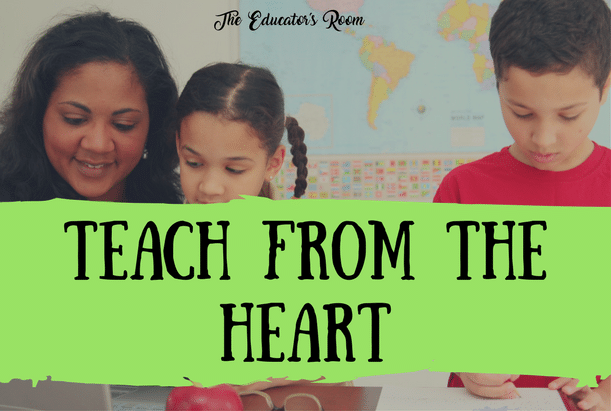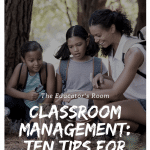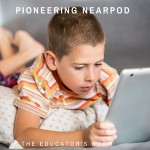1 Samuel 16:7: “The Lord does not see what man sees. While man looks at the outward appearance, the Lord looks at the heart.” Teaching is personal. Teaching is tireless and endless. We get the best gift a parent can give us, their child, and we are trusted to move them forward on their path of life. There are standards and tests and demands and legislation and lack of funds and struggles and it often seems our energy is depleted on meaningless, trivial things. Teaching is personal and it matters when we teach from the heart.
The haul from January trough spring break feels the longest in the educational calendar. Winter brings less movement and play outside, the lack of sun can cause depression in many and state assessments start. There is often tension and stress during this time of the year that feels endless; but keep your eye on the prize and use this time to move forward with your students.
In August I always assess and observe my students to understand their personalities, strengths and ways they need guidance and assistance to be successful in my classroom. I am proud of my students. They have grown so much this year in their communication and problem solving. They are hard workers, respect each other and help everyone be successful in our classroom. This does not just happen though. There is a process to learning about your students and making connections with them is the most important job you have as an educator. It is ongoing and happens all year long.
They Are All Your Students
You may have a needy dependent student who asks for guidance with every step of a lesson, lab or situation. There is a reason behind that need. Maybe they are in charge of younger siblings at home while a parent works. Maybe they need confidence. With connections , love and support you will see them problem solving and trying new things with prompting. You may have a shy quiet student who is eager to please by doing everything promptly and independently. they may be an older sibling who helps around the house. They may have no siblings and get attention and adult interactions daily. But they also need your connection to learn to speak up, share ideas and interact with peers. You may have an anxious child who asks for help when confused or stuck. They need connections to learn to embrace failure in learning instead of being afraid of failure. There is so much growth. And all of these things are reflections of the people my children are becoming. You may have a struggling student in academics. They need connections to have their heart full before they can focus on and put effort into academics. And you may have an academically high student that acts out and is the class clown because learning is “easy”. They need connections and support to think about standards above your grade level and use depth of knowledge to synthesize and apply the concepts they understand. Behaviors are reflections of their hearts.
Make Connections
Just as in August, take time this winter to make connections. Do some getting to know you activities and share information about yourself with your students. If you feel your classroom community is strong, continue to build upon that. You can do any of the following activities (and probably already have). If you are struggling with classroom management, purposefully build your community.
- Make a List–use your class list and think of two things you love and admire about each student. Do they make you laugh? Are they creative? How do they treat others? Are they helpful? Write down two positive things about each student.
- Have a Meeting–have your class sit in a circle, so all are included, and talk about how you envision your classroom community. Make a list together and ask students to share what they need from you. Be sure this is your students voice and not yours, the hard part is being quiet. Then ask students to share what their responsibilities are. Again, use their voice. How should they interact? Show listening? Work? Hang this in the classroom as a sort of constitution for your classroom.
- Compliment Each Other–Read “All the Good Things” from Soup for the Soul*. Discuss the idea with students of writing good things about each other. I have then applied this to my classroom in two different ways. Discuss compliments and thinking of things people do and share and have accomplished. Talk about the difference between superficial things (hair, clothes, etc.) and personality traits (courage, hard work, etc.). With both options below be sure to model compliment for your students throughout the end of the year.
- One option is to have students take out a paper and do the activity from the story. I play soft music and have them reflect, write, and then pass. No talking is allowed and I do not let the student get their own paper back. I encourage them to read the responses and think of something new to add to the list. I stop the papers about 3-4 people before they reach their owner. I collect the papers and then type up the responses. I always add “You are special!” to the end. These are then printed and laminated. I make them business card size. About a week later I remind them of the activity and pass out the cards. I tell them they are personal and should not be shared at school, but they are true statements that someone thinks about them. It is amazing to watch them read the compliments.
- A second option is to use anonymous notes. You can use sticky notes or simply dry erase markers on the desks. I explain to my students they can write a compliment to a classmate when they see them display a positive character trait. We discuss being positive and not leaving your name. The important thing is to compliment someone. If there is already a compliment a second one cannot be added. Once it is read by the owner it is to be erased or the note removed. This needs to be done with a class that has positive behaviors already in place as you may not see every note left.
- Have Fun–dance and sing and be silly together. Take time for brain breaks. Learning is hard work and it is important to acknowledge this with students. Students learn once they know they are in a safe environment and you care. When you build relationships their academic learning will then be able to grow.
Teaching goes beyond the paperwork and hoop jumping; it’s about the connections we make with our students. Reflect this winter and LOVE your children. Tell them each why they are important to you. Leave them a note to tell them an amazing thing you have seen them do. Model kindness and gratitude and watch that spread. Look at their heart.
*Mrolsa, Helen P. “All the Good Things.” All the Good Things | Chicken Soup for the Soul. Chicken Soup for the Soul, n.d. Web. 05 Feb. 2017.







